Ditapis dengan

Kemiskinan dan Ekonomi Mei 2013
IHK umum April 2013 dibandingkan Maret menunjukkan deflasi sebesar -0,1%. Hal ini adalah koreksi terhadap inflasi yang luar biasa tinggi sebesar 0,6% pada Maret 2013. Namun, inflasi year-on-year untuk April (5,6%) cenderung tinggi, lebih tinggi dibandingkan 2012 (4,5%) namun lebih rendah bila dibandingkan 2011 (6,2%). Target inflasi pemerintah sebesar 4,9% akan sulit dicapai karena inflasi year…
- Edisi
- -
- ISBN/ISSN
- -
- Deskripsi Fisik
- PDF, 2 Halaman
- Judul Seri
- Policy Brief
- No. Panggil
- 362.5 USA.K

Kemiskinan dan Ekonomi Maret 2013
Inflasi meningkat pesat pada 2013 dengan tingkatinflasi umum (headline inflation) pada Februari 2013 sebesar 0,75% dan inflasi year-on-year sebesar5,3%. Nilai ini lebih tinggi dibandingkan pada Februari 2012 (3,6%) namun tidak lebih tinggi dari standar selama ini: tingkat inflasi dari 2007 ke 2011 berkisar antara 2,8% hingga 11,1% per tahun. Kontributor terbesar inflasi Februari adalah hargabah…
- Edisi
- 1
- ISBN/ISSN
- -
- Deskripsi Fisik
- PDF, 2 Halaman
- Judul Seri
- Policy Brief
- No. Panggil
- 362.5 USA.K

Poverty and the Economy August 2013
As expected, the inflation rate for the month of July was 3.29%, more than three times June inflation of 1.1%. The major contributors to inflation this month were a 9.6% increase of transportation costs as a result of the fuel subsidy reduction and 5.5% and 1.5% of increase in price of food and processed food tied to the increase in fuel prices as well as the usual Lebaran food price incr…
- Edisi
- 1
- ISBN/ISSN
- -
- Deskripsi Fisik
- PDF, 2 Halaman
- Judul Seri
- Policy Brief
- No. Panggil
- 362.5 USA.P
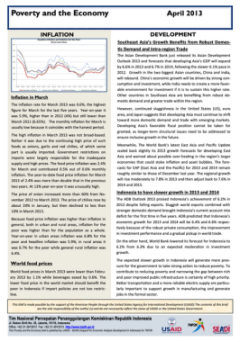
Poverty and the Economy April 2013
The inflation rate for March 2013 was 0.6%, the highest figure for March for the last five years. Year-on-year it was 5.9%, higher than in 2012 (4%) but still lower than March 2011 (6.65%). The monthly inflation for March is usually low because it coincides with the harvest period.
- Edisi
- -
- ISBN/ISSN
- -
- Deskripsi Fisik
- PDF, 2 Halaman
- Judul Seri
- Policy Brief
- No. Panggil
- 362.5 USA.P
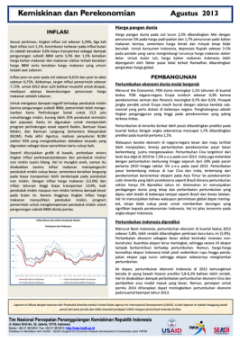
Kemiskinan dan Perekonomian Agustus 2013
Sesuai perkiraan, tingkat inflasi Juli sebesar 3,29%, tiga kali lipat inflasi Juni 1,1%. Kontributor terbesar pada inflasi bulan ini adalah kenaikan 9,6% biaya transportasi sebagai dampak pengurangan subsidi BBM serta 5,5% dan 1,5% kenaikan harga bahan makanan dan makanan olahan terkait kenaikan harga BBM serta kenaikan harga makanan yang umum terjadi saat Lebaran.
- Edisi
- 1
- ISBN/ISSN
- -
- Deskripsi Fisik
- PDF, 2 Halaman
- Judul Seri
- Policy Brief
- No. Panggil
- 362.5 USA.K
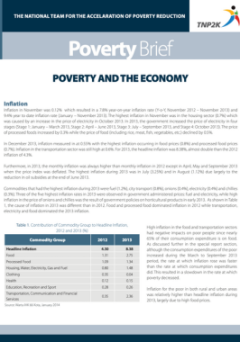
Poverty Brief Poverty And The Economy
Inflation in November was 0.12% which resulted in a 7.8% year-on-year inflation rate (Y-o-Y, November 2012 – November 2013) and 9.4% year to date inflation rate (January – November 2013). The highest inflation in November was in the housing sector (0.7%) which was caused by an increase in the price of electricity in October 2013. In 2013, the government increased the price of electricity …
- Edisi
- 1
- ISBN/ISSN
- -
- Deskripsi Fisik
- PDF, 4 Halaman
- Judul Seri
- Policy Brief
- No. Panggil
- 362.5 TNP.P
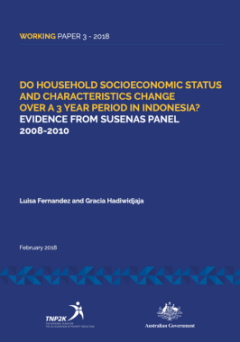
Do Household Socioeconomic Status And Characteristics Change Over A 3 Year Pe…
Database used to target social programs in Indonesia was updated every three years. Exclusion error and poverty dynamics in Indonesia have raised the question whether updating is required within that three year period. In this paper, we assess this issue by employing Susenas panel data to track changes in household characteristics and consumption mobility within three years. We find that househ…
- Edisi
- Working Paper 3 - 2018
- ISBN/ISSN
- -
- Deskripsi Fisik
- PDF, 34 Halaman
- Judul Seri
- Working Paper
- No. Panggil
- 330.9598 FER.D
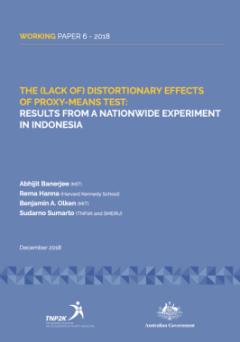
The (Lack Of) Distortionary Effects Of Proxy-Means Test:Results From A Nation…
Many developing country governments determine eligibility for anti-poverty programs using censuses of household assets. Does this distort subsequent reporting of, or actual purchases of, those assets? We ran a nationwide experiment in Indonesia where, in randomly selected provinces, the government added questions on flat-screen televisions and cell-phone SIM cards to the targeting census admini…
- Edisi
- Woking Paper 6 - 2018
- ISBN/ISSN
- -
- Deskripsi Fisik
- PDF, 36 Halaman
- Judul Seri
- Working Paper
- No. Panggil
- 330.9598 BAN.T
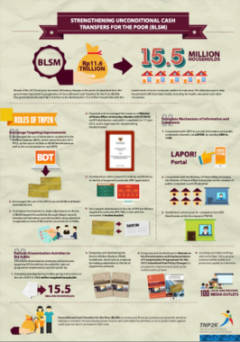
Strengthening Uncoditional Cash Transfer For The Poor (BLSM)
- Edisi
- -
- ISBN/ISSN
- -
- Deskripsi Fisik
- PDF, 1 Halaman
- Judul Seri
- Info Grafis
- No. Panggil
- 332 TNP. S
- Edisi
- -
- ISBN/ISSN
- -
- Deskripsi Fisik
- PDF, 1 Halaman
- Judul Seri
- Info Grafis
- No. Panggil
- 332 TNP. S
 Karya Umum
Karya Umum  Filsafat
Filsafat  Agama
Agama  Ilmu-ilmu Sosial
Ilmu-ilmu Sosial  Bahasa
Bahasa  Ilmu-ilmu Murni
Ilmu-ilmu Murni  Ilmu-ilmu Terapan
Ilmu-ilmu Terapan  Kesenian, Hiburan, dan Olahraga
Kesenian, Hiburan, dan Olahraga  Kesusastraan
Kesusastraan  Geografi dan Sejarah
Geografi dan Sejarah